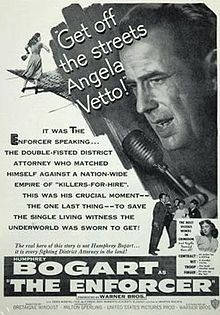| Reviews & Columns |
|
Reviews DVD TV on DVD Blu-ray 4K UHD International DVDs In Theaters Reviews by Studio Video Games Features Collector Series DVDs Easter Egg Database Interviews DVD Talk Radio Feature Articles Columns Anime Talk DVD Savant Horror DVDs The M.O.D. Squad Art House HD Talk Silent DVD
|
DVD Talk Forum |
|
|
| Resources |
|
DVD Price Search Customer Service #'s RCE Info Links |
|
Columns
|
|
|
Enforcer (1951), The
Because these later Bogie movies were made by a variety of companies for an equal variety of distributors, they weren't as easily packaged for television and home video distribution as is the case of Bogie's Warner Bros. films, hence some of these pictures have been a lot harder to see than others. The Enforcer (1951) was the only post-1948 Humphrey Bogart movie I hadn't experienced before. Happily, it's exceptionally good and it was particularly fun seeing it for the first time via Olive Films' notably crisp high-definition transfer. Though originally released by Warner Bros. - it was Bogie's last film for that company - it was chiefly an independent production made by United States Pictures, the company controlled by Milton Sperling, Harry Warner's son-in-law. Rights to all the United States Pictures movies released prior to 1960 now belong to Paramount through their acquisition of the Republic Pictures library.
The movie itself is a crackling, suspenseful film noir-police procedural with Bogie hunting down a murder-for-hire criminal organization based on Murder, Inc. ("Murder, Inc." was an early working title and it was released under that title outside the U.S.) Originally the plan was to name names and even include real former gangsters in the cast, but those ideas were dropped. Still, though fictionalized, many of the characters and incidents are closely patterned after the real thing, adding to its verisimilitude. The film has an outstanding supporting cast of seasoned but not famous actors, and the movie is so good it survives an awkward flashback-within-a-flashback structure that proved ruinous for an earlier Bogie film, Passage to Marseille (1944)
The film's first act is a stunner, so much so I wouldn't be surprised if it was originally intended for the third act but repositioned to get The Enforcer off to its spectacular start. Under heavy security, murder-for-hire gangster Joseph Rico (Ted de Corsia), the sole witness in a case against kingpin Albert Mendoza, is in the middle of the night secretly moved to the District Attorney's offices ahead of his court appearance, scheduled for later that morning.*
Rico is terrified. There have already been several attempts on his life, and even surrounded by police officers and despite the assurances of Assistant D.A. Martin Ferguson (Bogart), he's extremely pessimistic about his chances. One especially good bit has Ferguson trying to reassure Rico that Mendoza is safely locked up, but when Rico reluctantly peers into Mendoza's cell, Rico's former boss smiles at him. The camera doesn't show this, but stays on Rico so that the audience can watch his terrified reaction. This, of course, makes the unseen Mendoza seem almost supernaturally powerful. (He doesn't turn up onscreen until late in the story.)
The movie then shifts into flashback mode, as Ferguson and Capt. Frank Nelson (Roy Roberts) re-examine the case file of their original investigation. In flashbacks, Ferguson and Nelson attempt to track down contract killers and cut them deals so that they'll testify against Mendoza, but all are either too terrified or already dead: Mendoza is busily killing them off to cover his tracks. Later, when Mendoza's organization begins to unravel, more hit men - played by B-Western icon Bob Steele and Wallace Berry stand-in Harry Wilson - are brought in from Kansas City to pick up the slack.
The Murder, Inc.-like operation is slowly revealed via flashbacks-within-flashbacks taking the form of testimony provided by James "Duke" Malloy (Michael Tolan) who, emotionally devastated, claims he was forced to murder his girlfriend (The Wasp Woman's Susan Cabot); "Big Babe" Lazick (Zero Mostel), a bottom-rung hit man who joined the gang to provide for his family; and finally Rico himself. The film returns to the present for the climax, with Ferguson on the trail of a heretofore unknown witness to Mendoza's first contract hit, a witness whose identity comes to light in a clever plot twist attentive viewers will pick up on before Ferguson does.
The Enforcer is terrific and doesn't at all rely on Bogie's charisma alone to carry the film, as so many of his weaker, later films expected of him. Indeed, it's really more a showcase for busy supporting players like Roy Roberts, one of those authority figure types whose face is engrained after hundreds of movie and (especially) TV sitcom appearances, but whose name is unknown to nearly all. Others in plum roles include coarse-faced Ted de Corsia (The Naked City, The Killing); King Donovan (Invasion of the Body Snatchers), as the cop protecting him; soon-to-be-blacklisted Zero Mostel at his sweaty, comb-over best; Jack Lambert, who had a face like a Dick Tracy villain (and played one, in Dick Tracy's Dilemma); and Everett Sloane (Citizen Kane).
Largely forgotten Bretaigne Windust is the credited director but in fact he fell ill early on; an uncredited Raoul Walsh helmed most of the film. It's certainly a lot more like White Heat than Perfect Strangers.
The Enforcer is also much less dated than other police procedurals of its era, partly because it's so hard-hitting and willing to blur the lines between the good cops and bad gangsters (in one scene Bogie threatens to lock Lazick's frightened child away in an institution unless Lazick talks), but also because it's much more realistic and gritty. One shot, for instance, is a close-up of the dead girlfriend's murder file. The eyes are drawn to a flattering portrait of girlfriend, but pause it and take a look at the crime scene photo to the right, a gruesome photo of the same dead girl after her filthy corpse is discovered in a sedan pulled from the bottom of a swamp. How'd they get that past the censors?
Video & Audio
In its original full-frame, 1.37:1 format The Enforcer looks great, its original film elements clearly having survived changing hands multiple times. Detail is strong while the blacks, critical in noir like this, are like India ink. The Region A disc has strong audio as well, English only with no subtitle options. Alas, no Extra Features.
One other note: Kudos to whomever is designing Olive's Blu-ray cover art and menu screens. I'm not at all a fan of Criterion's often pretentious, occasionally baffling artwork, but for these library titles Olive's people always manage to locate and position archival ad art exactly right. Marvel at the cover art above.
Parting Thoughts
Hard-hitting and uncompromising, The Enforcer is terrific, the kind of classic movie even those who avoid old black-and-white films would find totally engrossing. Even without extra features, the good transfer and the movie itself make this a must-see. A DVD Talk Collector Series title.
* Murder, Inc.'s heyday was the 1930s while the trials stretched into the 1940s. It's not entirely clear to me if The Enforcer is set a dozen or so years in the past but it vaguely seems to be. Older automobiles dominate, and in early scenes Ferguson & Co. are initially unfamiliar with terminology like "contracts" and "hits," jargon that originated with Murder, Inc. My guess is that it's meant to be set around 1940, but plays fast and loose with period details.
Stuart Galbraith IV is a Kyoto-based film historian whose work includes film history books, DVD and Blu-ray audio commentaries and special features. Visit Stuart's Cine Blogarama here.
|
| Popular Reviews |
| Sponsored Links |
|
|
| Sponsored Links |
|
|
| Release List | Reviews | Shop | Newsletter | Forum | DVD Giveaways | Blu-Ray | Advertise |
|
Copyright 2024 DVDTalk.com All Rights Reserved. Legal Info, Privacy Policy, Terms of Use,
Manage Preferences,
Your Privacy Choices | |||||||














